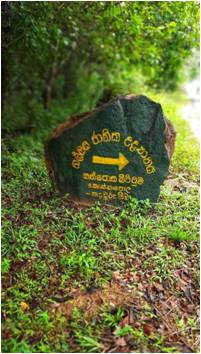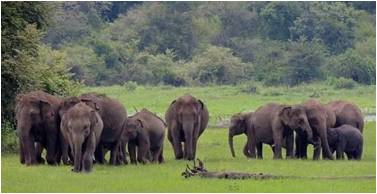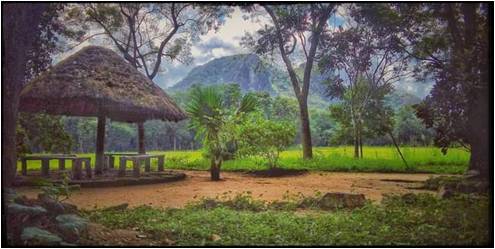Episode 33 – Senanayake Samudraya Sanctuary

Starting of the Sri Lanka’s first wildlife boat service
I joined the Wildlife Department on June 3, 1996, as a Class 3 Wildlife Ranger. At first, I was in charge of the Kataragama site for about 6 months, and then in January 1997, I was appointed as the in charge of the Meegala site on the west side of Galoya National Park.
Galoya National Park is located around the Senanayake Reservoir. It is managed by the custodian of Ingniagala Park. There is an area of 25,900 hectares here. There are four main zones: North, South, West, and East, to facilitate the control of the dam. That is, the northern side is the Mullegama site, the southern side is the Baduluwela site, the western side is the Nilgala site, and the eastern side is the Inginiagala park Central site.
The park’s official headquarters is located below the reservoir dam in Senanayake Samudra. But earlier, it was on top of reservoir dam. At present, Ingniagala old Park warden’s bungalow has been modified into a tourist bungalow.
I was assigned duties on the West Galoya side. In other words, the Ratugala and Nilgala tribes lived on the side of the Nilgala site. Their family name is Dunigala Maha Bandaralage. At that time, ‘Randuna’ Vannia was the leader of the village. Now his son, ‘Suda Vannia’, is the leader of the tribe.
The Senanayake Samudraya was built by damming up the Galoya River during the 1949–1953 era. In the past, the Nilgala Loggalwela area was an isolated village where indigenous people lived. When the 25,900-hectare National Park around Senanayake Samudra was gazetted, around 20 old villages were removed and taken over under the Galoya Development Project. The villages of Henebedda and Danigala, described in the literary works by R. L. Spittle, were submerged in the Senanayake Samudraya. Indigenous people who lived in those places have now settled in Ratugala. The Nilgala site of Loggalwela is one such relocated village.
The Nilgala site is located in 10 km of the southern side of the forest by the village called Bulugala, which is at the 20 km Bibila Nilgala road. This is an office built in the year 1950. There was a bungalow called Lopgalwela Bungalow where the white people who came to hunt stayed. There are ruins near the new office. That is why people still call the new office Lopgalwela Bungalow.The environment of Nilgala West is different, and it is a savanna forest. There are aralu, bulu, and nelli plants. These plants are called “Davi” in Sinhala. The meaning of the name of ”Davi” plants is that they will not die if caught in the fire. It also has pangirimana plants as well.
The Galoya River, which starts from Dorabora hill between Lunugala and Passara above Bibila village, passes through Bibila and Adhiwala villages for about 20 km, passes through the Nilgala Savanna forest, and falls into the Senanayake Samudraya from a place called Makara, which is located between a mountain range. From there, it is 11 km to the reservoir dam of the Senanayake Samudraya. Near Makara, the Gal Oya River goes underground, and no river can be seen above. At the beginning of the reservoir, the river rises again.
The Senanayake Samudra has been built by damming up the Galoya River. It is spread over 3927 hectares. Senanayake Samudraya was gazetted as a sanctuary on February 12, 1954. While supplying irrigation water to the farmers from the Senanayake Samudraya, water is also taken to the power plant. Fishermen engage in fishing there. Connecting the Inginiagala ‘Igini’ hill with the south ‘Dangolla’ hill on the opposite side, the 140-foot-high and 3600-foot-long reservoir dam has been built using earth.
Senanayake Samudraya is the largest reservoir in Sri Lanka, and it holds 777,000-acre feet of water. The high mountains that were submerged under the reservoir still emerge as islands in the Senanayake Samudraya. There are more than 10 such islands. All these islands are hunting grounds and breeding grounds for aquatic birds in Sri Lanka. Thousands of birds make nests on these small islands. Kurulu Island, Nabili Gala Island, and Sandagiri Pawwa are some of these islands. The name “Sandagiri Pawwa” was coined by Pandith W.D. Amaradeva, Mr. Dharmasiri Gamage, and Mr. Pushpananda, the caretaker of the park, when they stayed on the island on a moonlit day in the year 1997.
The reservoir was built by damming up the main river, Gal Oya. However, not only Gal Oya but several other streams fall into the reservoir. Badulu Wela Oya, Sellakka Oyastreaming from the south side, Gurulu Oya starting from Buddama mountain range, Mullegama River coming from north Mullegama, and Kadella Bay Aru coming from Dangala mountain range fall into the reservoir.
Now this island is used as a wildlife camping ground. Elephants swim to these islands every day of the year. The reason is that before the construction of the reservoir dam in 1949, the migration corridor of elephants used to pass through this rout. That is why elephants are still swimming from island to island along those routes. This scene is very attractive.
Based on this incident, I started a boat service in 2008 as the Warden of the Park. The boat that was supposed to patrol the reservoir was used first. Boats come from the reservoir dam side to Makara and return to the reservoir dam side. Starting with one boat, the number of boats increased to three. Initially a journey of 06 hours, and later, with the increased demand, 3 boat trips of 3 hours each started at 6.00 am, 9.30 am, and 3.00 pm. Of these, the 6 a.m. and 3 p.m. boat services are very popular.
One boat has eight seats, while life jackets and a trained boat operator and guide are provided by the wildlife department. Then, ten passengers are possible in total. Tickets for the boats can be purchased from the Inginiagala Park Warden’s office. Senanayake Samudraya is located on the road from Pasikuda, Arugambe, to Badulla, which is a route used by foreign tourists to Sri Lanka. Therefore, the boat service became popular among foreign tourists. Initially, income from boat service was Rs. 18,000/-, and now it has increased to more than Rs. 100 lakhs per year.
As of today, two large tourist hotels and other tourist accommodation facilities have been set up there. Apart from this, only 130 fishing boats are used for fishing in the reservoir.
It is my achievement to start this tourist boat service. I will never forget it. Although there are many forest-related memories in my life, starting the boat service is special among them.
Mr. Budhika Withanage

Mr. Budhika Withanage was born on February 5, 1972, in Matara. He started his studies at Kirinda Puhulwella Junior School. After passing the fifth scholarship, he entered Rahula College, Matara, and studied there up to the G.C.E. Advanced level. Mr. Buddhika Withanage joined the Department of Wildlife Conservation in 1996 as a Grade 3 Wildlife Range Officer. During that period, he had the opportunity to work in the Kataragama and Nilgala sites, Lunugamwehera, and Yala National Parks.
In the year 2006, Mr. BuddhikaWithanage, who was promoted to Wildlife Ranger Grade 2, was appointed as the Park Warden of Galoya National Park. Since then, he has worked as a Park Warden in Galoya National Park for 6 years and in Yala and Minneriya National Parks. In 2013, he got the opportunity to come back to Galoya National Park as a Park Warden for the second time. Meanwhile, he was promoted to Class 01. After working in Mannarand MaduruOya National Parks, he is currently working in Lahugala National Park.
BudhikaWithanage has completed 28 years of service as of now. In 1997, he completed the diploma course in Wildlife Conservation at the University of Colombo. As part of that he got the opportunity to study at the Institute of Wildlife Studies in Dehradun, India, for 3 1/3 months. He had the opportunity to visit Malaysia for 3 weeks in 2018 and China for 3 weeks in the summer of 2014.
He writes adventure stories about the Department of Forests on social media as a hobby. Mr. Buddhika Withanage married Mrs. Nishanthi Dilrukshi Hettiarachi. She was a student at Sujata College, Matara. She studied at Siane College of Education and is currently working as a science teacher at Kongala Maha Vidyalaya, Hakmana.
They have two sons. The elder son, Sinath Sakalya Vitanage, is preparing to sit the GCE Advanced Level exam in the mathematics stream in the year 2024 at Rahula Vidyalaya. The second son, Vihat Vithanage, is studying in Grade 8 at Rahula Vidyalaya. Buddhika Withanage’s address is Ketaki, School Lane, Kamburupitiya Road, Kirinda, Puhulwella, and his telephone number is 0719800777.
Senanayake Samudraya Sanctuary

Under Sri Lanka’s first multi-purpose irrigation project, founded in 1949/1950 by the first Prime Minister of independent Sri Lanka, Hon. D. S. Senanayake, the large reservoir formed by damming up Galoya was named Senanayake Samudraya, and it was the largest irrigation reservoir in Sri Lanka at that time. As an offshoot of the construction of the Senanayake Samudraya with a water capacity of 770,000 acre-feet, 2590 hectares of water catchment area near the reservoir were declared Gal Oya Park and 9324 hectares of irrigation reservoir as Senanayake Samudraya Sanctuary on 12.02.1954. This park belongs to the Monaragala and Ampara districts in the eastern part of the island.


In order to permanently maintain the conservation of the area as well as the conservation of wildlife, under the Flora and Fauna Protection Ordinance, taking into consideration the protection of the Senanayake Samudraya and surrounding watershed forests as a priority, four wildlife protected areas were established as Galoya National Park, Senanayake Marine Sanctuary, Galoya Valley Northeast Sanctuary with 12432 hectares, and Galoya Valley Southwest Sanctuary with 15281 hectares by the Galoya Development Board in 1954.
Located in the dry zone of the island, with an average annual rainfall of 1600–1700 mm, these parks receive rain during the northeast monsoon. Located near the Senanayake Samudraya, the soil of this land is red-brown in color. Over 25,000 hectares of evergreen forests and open savannas surround the Senanayake Samudraya, Sri Lanka’s largest inland body of water. The islets that emerged from the reservoir are spread throughout this reservoir.

The garden around the Senanayake Samudraya Sanctuary consists of plants native to the dry zone. There are three types of wild vegetation found in this park. About 45% of it is covered by evergreen forests and consists of jungles, shrubs, and grasslands; another 33% is grassland; and 9% is hilly grassland. On both sides of the valley, at the foot of the mountains, there are very rich grasses and medicinal plants growing. The three main medicines of Ayurveda, Aralu (Terminalia chebula), Bulu (Terminalia bellirica), Nelli (Phyllanthus emblica), and Gammalu (Pterocarpus marsupium), as well as grasses like Mana (Cymbopogon confertiflorus) and Illuk (Imperata cylindrica), are also abundant. The tall plants in this forest are Halmilla (Berraya cordifolia), Etamba (Mangifera zeylancia), Kalumediri (Diopyros chaetocarpa), Weera (Dryptes sepiaria), Palu (Manilkara hexandra), Ebony (Diospyros altissima), Divul (Limonia acidissima), and grasses. A number of native trees, such as Zizyphus sps., are found in abundance.



Nearly 150 different bird species which adorns the sky above the park nest on the islands surrounding the reservoir. The islets in the reservoir which are used by bird for nesting purpose are called Bird Islands. The park with a thick green canopy is a haven for birds and close to the reservoir, Heron, (Ardeidae Sps.) Cormorant (Phalacrocorax fuscicollis), Gray heron (Ardea cinerea) and Lesser whistling duck (Denbrocygna javanica) and hawk species are common. Lesser Adjutant (Leptoptilos javanicus), Spot-billed Pelican (Pelecanus philippensis), Sri Lanka gray hornbill (Ocyceros gingalensis), Sri Lanka Red Faced Malkoha (Phaenicophaeus pyrrhocephalus), Sri lanka junglefowl (Gallus lafayetii), Sri lanka Spurfowl (Galloperdix bicalcarata), brown capped babbler (Pellorneum fuscocapillus) etc. are bird species that live in the interior of the sanctuary.










Because there is an abundance of water throughout the year and green shade to keep them comfortable, the National Park is particularly wildlife-friendly. Therefore, one of the most important features of Galoya National Park is the herd of elephants that can be seen throughout the year. Galoya National Park is one of the best places in the world to see Asian elephants (Elephas maximus) living peacefully in their natural habitat. Elephants are also the strongest swimmers of all mammals. In Galoya National Park, exemplifying the harmony between wildlife and environment, from March to July, you can see herds of elephants swimming from one island to another in the Senanayake Samudraya Reservoir by boat safari. Nearly 32 mammals have been recorded in the park, including the Sri Lanka elephant, wild buffalo (Bubalus arnee), sambar (Rusa unicolor), leopard (Panthera pardus kotiya), sloth bear (Melursus ursinus), barking deer (Muntiacus muntijak), spotted deer (Axis axis ceylonensis), gray langur (Semnopithecus entellus), toque macaque (Macaca sinica), and wild boar (Sus scrofa). Reptile species in the park include the mugger crocodile (Crocodylus palustris), star tortoise (Testudo elegans), flapshell turtle (Lissemys ceylonensis), Parker’s black turtle (Melanochelys trijuga), Python (Python molurus), and cobra (Naja naja).



Asian elephant (Elephas maximus)



Swimming Elephants

As you ride along the still waters of the Senanayake Samudraya Tank, you will soon realize that Gal Oya National Park is teeming with life. The serene environment of the park allows tourists to explore with maximum freedom.



This dry mixed evergreen park is located about 368 km from Colombo. The park entrance is located at Inginiagala, 20 km west of Ampara. Galoya National Park can be reached from Colombo via Ratnapura, Pelmadulla, Balangoda, Wellawaya, Monaragala, Siambalanduwa-Ampara road by turning at the 17th milepost in Iginiagala, and also via Colombo, Kandy, Mahianganaya, Ampara to Iginiagala. Crossing the Senanayake Sea by boat from Iginiagala is an alternative way to enter Galoya National Park.




Tourists are provided facilities by the Department of Wildlife Conservation, and permission must be obtained from the Head Office of the Wildlife Department to stay in tourist bungalows. Wildlife tourist bungalows are located at Ginniagala, Ekgal Oya, and Nilgala, and campsites are established at Senanayake Samudrasanna, Pareviyanara, Mahdorovwa, and Kossapola. Also, it is possible to travel by jeep from Mullegama to Kulabokka and from Alivanguwa to Kossapolla.

List of animals in the Senanayake Samudraya Sanctuary
Sinhala Names | Tamil Names | English Names | Scientific Name |
කොකා | கொக்கு | Heron | Ardeidae Sps. |
දියකාවා | நீர்க்காகம் | cormorant | Phalacrocorax fuscicollis |
අළු කොකා | சாம்பல்நாரை | Grey Heron | Ardea cinerea |
තඹසේරුවා | சிறிய சீழ்க்கைச்சிரவி | Lesser Whistling Duck | Denbrocygna javanica |
බහුරුමානාවා | சிறுத்த பெருநாரை | Lesser Adjutant | Leptoptilos javanicus |
පැස්තුඩුවා | சாம்பல் கூழைக்கடா | Spot-billed Pelican | Pelecanus philippensis |
ශ්රී ලංකා අළුකෑදැත්තා | இலங்கை சாம்பல் இருவாய்ச்சி | Sri Lanka Grey Hornbill | Ocyceros gingalensis |
රතු මුහුණැති මල්කොහා | செம்முகப் பூங்குயில் | Sri Lanka Red Faced Malkoha | Phaenicophaeus pyrrhocephalus |
වළිකුකුලා | இலங்கை காட்டுக்கோழி | Sri Lanka Junglefowl | Gallus lafayetii |
හබන්කුකුලා | சின்னக் காட்டுக்கோழி | Sri Lanka Spurfowl | Galloperdix bicalcarata |
ලංකා මුදුන් බොර දෙමලිච්චා | பழுப்பு நிற மூடிய புழுணி | Brown Capped Babbler | Pellorneum fuscocapillus |
මල් පිලිහුඩුවා | சிரல் | Common Kingfisher | Alcedo atthis |
මානම් / පතන් කුකුළා (තිත් වටු-කුකුළා) | வண்ணந்தீட்டியக் கவுதாரி | Painted Francolin | Francolinus pictus |
මැඩි-මූණා | இலங்கை தவளைவாயன் | Frogmouth | Batrachostomus moniliger |
උලමා | பெரிய காட்டு ஆந்தை | Spot-bellied Eagle Owl | Bubo nipalensis |
කොණ්ඩරාජාලියා | குடுமிக் கழுகு | Changeable Hawk Eagle | Spizaetus cirrhatus |
මුහුදු රාජ අලියා | கடல் பருந்து | White-bellied Sea Eagle | Haliaeetus leucogaster |
අලියා | ஆசியயானை | Asian Elephant | Elephas maximus |
මීහරකා | எருமை | Wild Buffalo | Bubalus arnee |
ගෝනා | மரை | Sambar | Rusa unicolor |
ශ්රී ලංකා දිවියා | சிறுத்தை | Leopard | Panthera pardus kotiya |
වලසා | கரடி | Sloth Bear | Melursus ursinus |
මුවා | மான் | Barking Deer | Muntiacus muntijak |
තිත්මුවා | புள்ளிமான் | Spotted Deer | Axis axis ceylonensis |
අළුවදුරා | சுள்ளிய சாம்பல் குரங்கு | Gray Langur | Semnopithecus entellus |
රිළවා | செங்குரங்கு | Toque Macaque | Macaca sinica |
වල්ඌරා | காட்டுப்பன்றி | Wild Boar | Sus scrofa |
හැලකිඹුලා | சதுப்பு முதலை | Mugger Crocodile | Crocodylus palustris |
තාරකාඉබ්බා | நட்சத்திர ஆமை | Star Tortoise | Testudo elegans |
කිරිඉබ්බා | பால் ஆமை | Flapshell Turtle | Lissemys ceylonensis |
ගල්ඉබ්බා | கல் ஆமை | Parker’s Black Turtle | Melanochelys trijuga |
පිඹුරා | மலைப்பாம்பு | Python | Python molurus |
නයා | நாகம் | Cobra | Naja naja |
List of trees in the Senanayake Samudraya Sanctuary
Sinhala Name | Tamil Name | English Name | Scientific Name |
අරළු | கடுக்காய் | Aralu | Terminalia chebula |
බුළු | தான்றி | Bulu | Terminalia bellirica |
නෙල්ලි | நெல்லி | Nelli | Phyllanthus emblica |
ගම්මාලු | வேங்கை | Gammalu | Pterocarpus marsupium |
මාන | மானா | Mana | Cymbopogon confertiflorus |
ඉලුක් | தர்ப்பைப்புல் | Illuk | Imperata cylindrica |
හල්මිල්ල | சாவண்டலை மரம் | Halmilla | Berraya cordifolia |
ඇටඹ | காட்டுமா | Etamba | Mangifera zeylancia |
කළුමැදිරි | பதுரங்கலி | Kalumediri | Diopyros chaetocarpa |
වීර | வீரை | Weera | Dryptes sepiaria |
පලු | பாலை | Palu | Manilkara hexandra |
කළුවර | கருங்காலி | Ebony | Diospyros altissima |
දිවුල් | விளா | Divul | Limonia acidissima |
එරමිණියා | இலந்தை | Zizyphus sps. |
Editor– Dammika Malsinghe, Additional Secretary,Ministry of Wildlife and Forest Resources Conservation (MWFRC)
Article on park written by– Hasini Sarathchandra, Chief Media Officer, Department of Wildlife Coservation (DWLC) Mahesha Chathurani Perera ,Development Officer, (DWLC)
Tamil Translations– A.R.F. Rifna, Development Officer, MWFRC
English Translations – Asoka Palihawadana, Translator, MWFRC
Web Designing–N.I.Gayathri, Development Officer,MWFRC
-C.A.D.D.A. Kollure, Management Service Officer, MWFRC
Photography– Rohitha gunawardena, DWLC